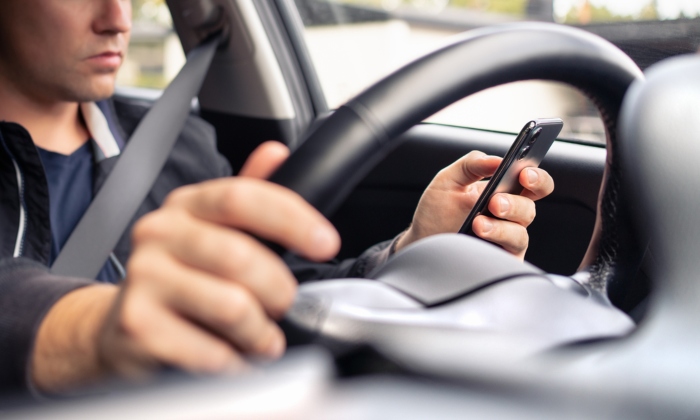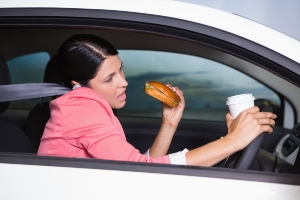
Unsafe driving habits contribute significantly to roadway accidents and fatalities. According to NHTSA, the riskiest driving behaviors include drunk driving, drug-impaired driving, distracted driving, speeding, and drowsy driving. Unfortunately, many drivers still engage in unsafe driving behaviors, needlessly endangering not just themselves and their passengers but others on the road. Understanding these risky driving behaviors can help you be a more defensive driver.
Below are common dangerous driving behaviors that often contribute to accidents.
Drunk Driving
Every day, approximately 34 people in the U.S. die in drunk driving accidents; that translates to one person every 42 minutes (2023 data, NHTSA) or 12,429 alcohol-impaired driving deaths.
The reality: Alcohol significantly impairs judgment, coordination, and reaction times, increasing the likelihood of deadly crashes.
Drug-impaired driving
“Marijuana can make you a safer driver.” Not true. Research shows that marijuana impairs motor skills, lane tracking, and cognitive functions.
Bottom line: driving while impaired by any substance is against the law
Distracted Driving
Distracted driving took 3,275 lives in 2023 (NHTSA). Whether manual, visual, or cognitive, distractions greatly reduce a driver’s ability to react and make safe decisions.

Best practice: Stay focused on the road and avoid any activity that takes your hands, eyes, or mind off driving.
Speeding
In 2023, speeding killed 11,775 people (NHTSA).
“For more than two decades, speeding has been involved in approximately one-third of all motor vehicle fatalities. In 2023, speeding was a contributing factor in 29% of all traffic fatalities.” (NHTSA)
The probability of serious injury, or even death, increases with impacts at higher speeds, doubling for every 10 MPH over 50 MPH a vehicle travels.
Slow down: Follow speed limits and adjust your driving to suit weather and road conditions.
Drowsy driving
 Being fatigued while driving can be as dangerous as driving impaired (under the influence of alcohol).
Being fatigued while driving can be as dangerous as driving impaired (under the influence of alcohol).Stay alert: Get adequate rest before driving to ensure your safety and the safety of others.
Reckless Driving & Road Rage
Reckless driving includes things such as tailgating, cutting off other drivers, weaving in and out of traffic, and making sudden lane changes.
Road rage is a “fit of violent anger by the driver of an automobile, especially one directed toward and endangering other motorists or pedestrians.” It may include swerving in front of another vehicle, stopping abruptly, blocking other vehicles from passing, or purposely making contact with another vehicle.
Avoid aggressive driving: Stay calm, courteous, and focused on the road. It can easily graduate into road rage.
Seat belts are life-saving devices:
 According to NHTSA, seat belt use in passenger vehicles saved an estimated 14,955 lives in 2017.
According to NHTSA, seat belt use in passenger vehicles saved an estimated 14,955 lives in 2017.
Seat belts save lives and should be worn whether in the front seat or back. Do not rely on air bags alone. They will not protect you unless you are wearing a proper restraint. The force of an airbag can cause severe injuries when not secured by a seat belt.
Make it a habit to buckle up, whether you are in the front or back seat.
Additional dangerous habits include:
 Failing to yield or give the right of way.
Failing to yield or give the right of way.Any of these dangerous driving behaviors can contribute to an accident. Know whether you are engaging in unsafe driving behaviors.
If you have been injured in a motor vehicle accident in which you suffered serious injuries due to risky, unsafe driving behaviors, having a knowledgeable attorney who is your advocate can offer you peace of mind during your recovery. Call Nash & Franciskato at (877) 284-6600.
One of our experienced staff will speak with you personally and will provide you with a free, no-obligation review of your case.
START YOUR FREE CASE REVIEW TODAY
If you would like to receive news and blog updates regularly, sign up to receive our email newsletter. Your email address will only be used to send you our newsletter and respond to inquiries.
RESOURCES FOR YOU
Past results afford no guarantee of future results, and each case is different and is judged on its own merits. The choice of a lawyer is an important decision and should not be based solely upon advertisements.
Editor’s Note: This post was originally published on September 18, 2023. It was reviewed for content and accuracy on April 1, 2025. Statistics updated as of 12/17/25.
Photo Credits: